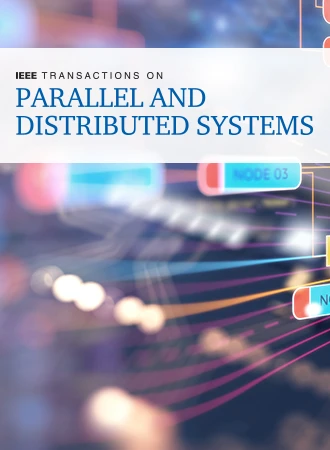SLO-Aware Function Placement for Serverless Workflows With Layer-Wise Memory Sharing
IF 5.6
2区 计算机科学
Q1 COMPUTER SCIENCE, THEORY & METHODS
IEEE Transactions on Parallel and Distributed Systems
Pub Date : 2024-04-22
DOI:10.1109/TPDS.2024.3391858
引用次数: 0
Abstract
Function-as-a-Service (FaaS) is a promising cloud computing model known for its scalability and elasticity. In various application domains, FaaS workflows have been widely adopted to manage user requests and complete computational tasks efficiently. Motivated by the fact that function containers collaboratively use the image layer's memory, co-placing functions would leverage memory sharing to reduce cluster memory footprint, this article studies layer-wise memory sharing for serverless functions. We find that overwhelming memory sharing by placing containers in the same cluster machine may lead to performance deterioration and Service Level Objective (SLO) violations due to the increased CPU pressure. We investigate how to maximally reduce cluster memory footprint via layer-wise memory sharing for serverless workflows while guaranteeing their SLO. First, we study the container memory sharing problem under serverless workflows with a static Directed Acyclic Graph (DAG) structure. We prove it is NP-Hard and propose a 2-approximation algorithm, namely MDP. Then we consider workflows with dynamic DAG structure scenarios, where the memory sharing problem is also NP-Hard. We design a Greedy-based algorithm called GSP to address this issue. We implement a carefully designed prototype on the OpenWhisk platform, and our evaluation results demonstrate that both MDP and GSP achieve a balanced and satisfying state, effectively reducing up to 63利用分层内存共享为无服务器工作流提供 SLO 感知功能布局
功能即服务(FaaS)是一种前景广阔的云计算模式,以其可扩展性和弹性而著称。在各种应用领域,FaaS 工作流已被广泛采用,以管理用户请求并高效完成计算任务。受函数容器协同使用映像层内存这一事实的启发,本文研究了无服务器函数的分层内存共享。我们发现,将容器放置在同一集群机器中进行压倒性的内存共享可能会导致性能下降和违反服务级别目标(SLO),原因是 CPU 压力增大。我们研究了如何通过无服务器工作流的分层内存共享最大限度地减少集群内存占用,同时保证其 SLO。首先,我们研究了具有静态有向无环图(DAG)结构的无服务器工作流下的容器内存共享问题。我们证明了这是一个 NP-Hard(NP-Hard)问题,并提出了一种 2-approximation 算法,即 MDP。然后,我们考虑了具有动态 DAG 结构场景的工作流,其中的内存共享问题也是 NP-Hard。我们设计了一种名为 GSP 的基于 Greedy 的算法来解决这个问题。我们在 OpenWhisk 平台上实现了一个精心设计的原型,评估结果表明,MDP 和 GSP 都达到了平衡和令人满意的状态,在保证无服务器工作流 SLO 的同时,有效减少了高达 63%$ 的缓存内存使用量。
本文章由计算机程序翻译,如有差异,请以英文原文为准。
求助全文
约1分钟内获得全文
求助全文
来源期刊

IEEE Transactions on Parallel and Distributed Systems
工程技术-工程:电子与电气
CiteScore
11.00
自引率
9.40%
发文量
281
审稿时长
5.6 months
期刊介绍:
IEEE Transactions on Parallel and Distributed Systems (TPDS) is published monthly. It publishes a range of papers, comments on previously published papers, and survey articles that deal with the parallel and distributed systems research areas of current importance to our readers. Particular areas of interest include, but are not limited to:
a) Parallel and distributed algorithms, focusing on topics such as: models of computation; numerical, combinatorial, and data-intensive parallel algorithms, scalability of algorithms and data structures for parallel and distributed systems, communication and synchronization protocols, network algorithms, scheduling, and load balancing.
b) Applications of parallel and distributed computing, including computational and data-enabled science and engineering, big data applications, parallel crowd sourcing, large-scale social network analysis, management of big data, cloud and grid computing, scientific and biomedical applications, mobile computing, and cyber-physical systems.
c) Parallel and distributed architectures, including architectures for instruction-level and thread-level parallelism; design, analysis, implementation, fault resilience and performance measurements of multiple-processor systems; multicore processors, heterogeneous many-core systems; petascale and exascale systems designs; novel big data architectures; special purpose architectures, including graphics processors, signal processors, network processors, media accelerators, and other special purpose processors and accelerators; impact of technology on architecture; network and interconnect architectures; parallel I/O and storage systems; architecture of the memory hierarchy; power-efficient and green computing architectures; dependable architectures; and performance modeling and evaluation.
d) Parallel and distributed software, including parallel and multicore programming languages and compilers, runtime systems, operating systems, Internet computing and web services, resource management including green computing, middleware for grids, clouds, and data centers, libraries, performance modeling and evaluation, parallel programming paradigms, and programming environments and tools.
 求助内容:
求助内容: 应助结果提醒方式:
应助结果提醒方式:


